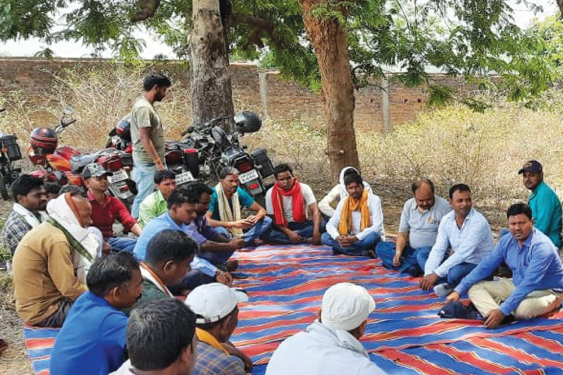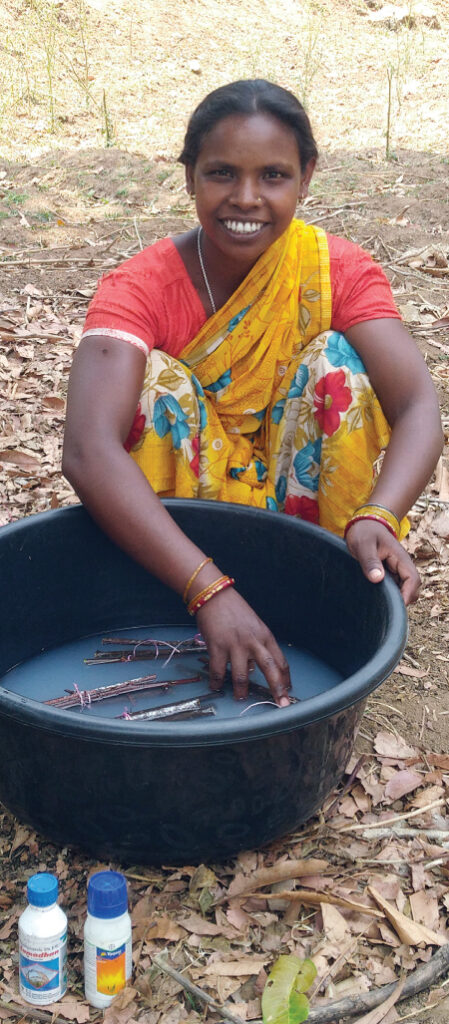Atiny insect, with assistance from human hands, is helping change lives in the remote tribal districts of Khunti and Hazaribag in Jharkhand. The hero here is Kerria lacca, a creature that feeds on the sap of certain trees and secretes a resin known as lac, a valuable ingredient for a variety of industries.
Cultivated by farmers in central and eastern India, many of them from tribal communities, lac’s worth stems from its extensive use as shellac and dyes in businesses ranging from paints and electricals to cosmetics, automobiles, furnishing and more. For Samkumari Sawasi, a tribal resident of Binda village in Khunti, this scarlet resin has opened the doors to a better future.
Farming entrepreneurship
Ms Sawasi is one of about 3,250 women farmers — entrepreneurs among them as well — who have bettered their lives through a lac value chain programme supported by Collectives for Integrated Livelihood Initiatives (CInI), an associate organisation of the Tata Trusts that has dug in deep with social and community development initiatives in the central India region.
A mother of two, Ms Sawasi grows grain and tomatoes and rears chicken while supplementing her family’s income through lac cultivation, from which she garners around ![]() 70,000 a year. That’s meaty money for Ms Sawasi and she has had to ward off the bane of farmers everywhere to get on firmer financial ground.
70,000 a year. That’s meaty money for Ms Sawasi and she has had to ward off the bane of farmers everywhere to get on firmer financial ground.
Bug attacks were the villain and, as Ms Sawasi found out, spraying pesticides was not the solution because the Kerria lacca insect also perished in the process. “It was only after joining the lac programme that we learned how to be rid of pests,” she says. This was one of a host of things Ms Sawasi learned as she adopted a package of scientific practices that enables her family to now cultivate “five-to-seven times more lac”.
Upping lac production is the key in an initiative that has, since its launch in 2015, been an income boon for the local Santhal and Munda tribal communities, especially their womenfolk. Family earnings from lac cultivation have multiplied and farmers have profited thanks to a combination of training, the creation of a market-led production hub, fair-price mechanisms and critical on-ground backing by CInI.
The lac initiative has expanded to span 44 villages and has recorded a 30% jump in productivity over the course of its seven-year timespan. The average annual income of farmers taking up lac cultivation has increased from ![]() 12,000 a year to
12,000 a year to ![]() 32,000 over the period.
32,000 over the period.
CInI has set up three handicraft units where women can earn salaries of at least ![]() 60,000 a year by making lac bangles and other items. A group of 22 women have become ‘lac entrepreneurs’ — suppliers of insect broods — and each makes upwards of
60,000 a year by making lac bangles and other items. A group of 22 women have become ‘lac entrepreneurs’ — suppliers of insect broods — and each makes upwards of ![]() 90,000 a year from the effort.
90,000 a year from the effort.

Birang Hassa, a lac cultivator from Janumpiri village in Khunti district, treats brood lac-bearing branches in an insecticide solution to eliminate pests that attack the lac-producing Kerria lacca insect
Sirshendu Paul, regional manager with the Tata Trusts, says that the lac initiative is one of the highlights of CInI’s Lakhpati Kisan programme, which works to help the most indigent farmers in its operational zone earn ![]() 100,000 or more annually through different livelihood options. “A tenth of the lac farmers we are involved with earn that much from lac alone,” he says.
100,000 or more annually through different livelihood options. “A tenth of the lac farmers we are involved with earn that much from lac alone,” he says.
It’s a rosy picture and a potential game-changer for lac cultivators in India, a major global producer of the resin. Lac grows best on young branches of the palash, ber and kusum trees. Cultivating lac is complex but it is less labour intensive than regular agriculture, and the payoff — up to ![]() 600 a kilo depending on variety and quality — makes it a good second-income source for rural communities.
600 a kilo depending on variety and quality — makes it a good second-income source for rural communities.
Then to now
Farmers in Jharkhand have collected lac from the jungle for ages and, more recently, have begun cultivating it on their farms. Output and quality are often compromised, though, by logistical issues and the farmers’ lack of scientific know-how.
Before CInI stepped in, farmers struggled to procure quality brood lac (insect nymphs) locally. The broods often had to be brought in from other districts or from nearby Chhattisgarh. Since a fresh brood has to be transplanted onto new branches within a narrow 36-hour window, the smallest delay or carelessness could cost farmers dearly.
There were other issues, too. Farmers were unaware of important steps in the lac cycle — proper pruning, harvesting and spraying of trees — and, therefore, ended up with lower-grade produce. They were also at the mercy of the unfair prices set by local traders, which further dented their incomes.
CInI was sure from the start that the programme’s principal need was for a science-based and market-linked lac value chain that would diversify and secure rural incomes. This was also a chance to give tribal women, a vulnerable subgroup within the scheduled tribe population, a shot at financial independence.
“Traditionally, women here were not involved in crop-related decision-making and planning. Lakhpati Kisan didn’t just involve them; it empowered them to become independent decision makers and entrepreneurs,” says Mr Paul.

Farmers from Jate village in Khunti harvesting lac from host trees
CInI began by partnering the Namkum-based Indian Institute of Natural Resins and Gums (IINRG). The team at the Institute designed the package of practices that CInI then took to the farmers and tribal women through field training sessions and pamphlets. “We set out to educate farmers from scratch about each stage of the lac cultivation cycle: from inoculation and pruning to harvesting and storage,” says Praful Patmanjhi, a technical officer at IINRG.
In 2018, CInI mobilised the programme’s women growers into two farmer producer companies (FPCs). Formed and run by the women themselves, these are critical elements in the lac value chain. They buy brood lac from locally-trained entrepreneurs and supply it to farmers, and they disburse the technical equipment provided by CInI (solar-powered tree-branch pruners, sprayer machines, pesticides, etc) at subsidised rates.

Farmers at a training session in Churchu village in Hazaribag district
Taking a shine to lac
Becoming an entrepreneur has opened the doors to an improved world for Philomina Bodra. This native of Bundu Mamail in Jharkhand’s Khunti district is one of 22 ‘lac entrepreneurs’ who have flowered under the umbrella of the lac value-chain programme seeded by Collectives for Integrated Livelihood Initiatives (CInI).
These lac entrepreneurs are tribal women who supply the Kerria lacca nymphs to lac cultivators in their villages. A lac farmer herself, Ms Bodra was surprised to see that focusing on the brood lac aspect of lac cultivation could be so profitable. With net earnings of more than ![]() 100,000 last year (besides what she makes from lac cultivation), Ms Bodra is on a lucrative streak.
100,000 last year (besides what she makes from lac cultivation), Ms Bodra is on a lucrative streak.
“I don’t have to ask my husband for money anymore,” says Ms Bodra, who uses the extra income she now makes for household expenses, with some even left over as savings. “We can now afford to hire labourers for our farm,” she adds.
CInI’s decision to support local lac entrepreneurs in supplying brood lac is based on solid logic. Introducing lac insects to host trees is a time-sensitive affair, and carting in brood lac on trucks from miles away carries risks of damage, delays and higher costs.
Having quality brood lac available through local entrepreneurs makes all the difference to profitability. “Training locals to create and supply brood lac to other farmers creates a sustainable ecosystem within the rural tribal economy,” says Sirshendu Paul, regional manager with the Tata Trusts.
Marketing the produce
At the vending end of the value chain, the FPCs aggregate the cultivated stick-lac from farmers and get it processed for sale. The lac is then sold to pre-selected vendors who offer the best rates for the produce. In the last four years, the FPCs have sold lac worth ![]() 2.9 million to vendors. Dealing directly with the FPCs enables them to sell in bulk and bypass unscrupulous traders.
2.9 million to vendors. Dealing directly with the FPCs enables them to sell in bulk and bypass unscrupulous traders.
The handicraft centres established by CInI train artisans to use lac to create bangles, pen stands, idols, etc. For this they are paid monthly salaries of ![]() 5,000 or more and CInI also takes them to exhibitions and helps them market their wares online.
5,000 or more and CInI also takes them to exhibitions and helps them market their wares online.
Extra money in the family kitty las led to the accruing of collateral social benefits and the realisation of objectives that may once have been considered farfetched. “My financial difficulties have eased and I can now afford to send my children to a private school,” says Fulmani Purty, a resident of Jate village in Khunti.
Rising income levels have also arrested outward migration for jobs. “At the start of the programme menfolk in 12% of the households were leaving their villages to find work elsewhere. Today that number is down to around 3%,” says Somnath Das, a lac thematic anchor with CInI.
The programme is set to add 800 beneficiaries by 2024 through a new CInI project funded by the government-owned National Bank for Agriculture and Rural Development, or NABARD. The intent is to get farmers to cultivate lac on semialata plants in fallow upland areas. Compared with traditional lac trees, semialata grows much faster and is easier to maintain. “We expect the project to add about ![]() 70,000 to each farmer’s annual income,” says Mr Paul.
70,000 to each farmer’s annual income,” says Mr Paul.
For all the progress made, there are challenges left to overcome. What CInI’s lac value chain has crafted, however, is a blueprint for progress that infuses modern knowledge into livelihood initiatives, such as to enable marginalised rural communities to grasp a financially secure future.
Article Credits: Tata Trust-Horizons
